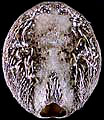The Echinoid Directory
Gonimaretia H.L. Clark, 1917, p. 240
| Diagnostic Features |
|
|---|---|
| Distribution | Recent, Philippines, 235-2460 m. |
| Name gender | feminine |
| Type | Gonimaretia tylota Clark, 1917, p. 241, by original designation. |
| Species Included |
|
| Classification and/or Status |
|
| Remarks |
|




